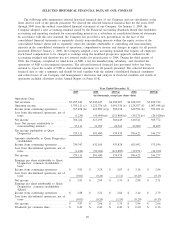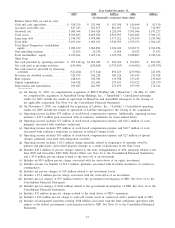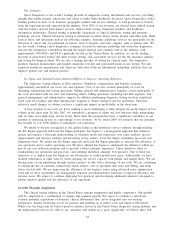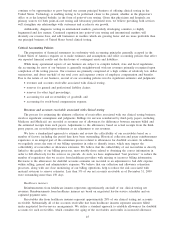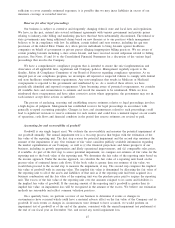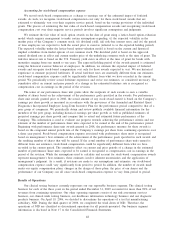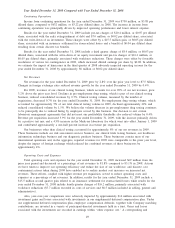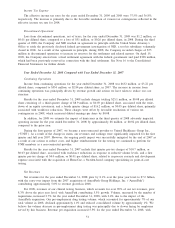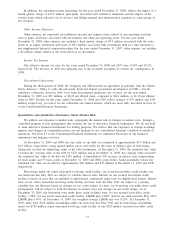Quest Diagnostics 2009 Annual Report Download - page 57
Download and view the complete annual report
Please find page 57 of the 2009 Quest Diagnostics annual report below. You can navigate through the pages in the report by either clicking on the pages listed below, or by using the keyword search tool below to find specific information within the annual report.sufficient to cover currently estimated exposures, it is possible that we may incur liabilities in excess of our
insurance coverage or recorded reserves.
Reserves for other legal proceedings
Our business is subject to extensive and frequently changing federal, state and local laws and regulations.
We have, in the past, entered into several settlement agreements with various government and private payers
relating to industry-wide billing and marketing practices that had been substantially discontinued. The federal or
state governments may bring additional claims based on new theories as to our practices which management
believes to be in compliance with law. In addition, certain federal and state statutes, including the qui tam
provisions of the federal False Claims Act, allow private individuals to bring lawsuits against healthcare
companies on behalf of government or private payers alleging inappropriate billing practices. We are aware of
certain pending lawsuits including a class action lawsuit, and have received several subpoenas related to billing
practices. See Notes 15 and 16 to the Consolidated Financial Statements for a discussion of the various legal
proceedings that involve the Company.
We have a comprehensive compliance program that is intended to ensure the strict implementation and
observance of all applicable laws, regulations and Company policies. Management regularly reports to the
Quality, Safety & Compliance Committee of our Board of Directors regarding compliance operations. As an
integral part of our compliance program, we investigate all reported or suspected failures to comply with federal
and state healthcare reimbursement requirements. Any non-compliance that results in Medicare or Medicaid
overpayments is reported to the government and reimbursed by us. As a result of these efforts, we have
periodically identified and reported overpayments. Upon becoming aware of potential overpayments, we consider
all available facts and circumstances to estimate and record the amounts to be reimbursed. While we have
reimbursed these overpayments and have taken corrective action where appropriate, the government may not in
each instance accept these actions as sufficient.
The process of analyzing, assessing and establishing reserve estimates relative to legal proceedings involves
a high degree of judgment. Management has established reserves for legal proceedings in accordance with
generally accepted accounting principles. Changes in facts and circumstances related to such proceedings could
lead to significant revisions to reserve estimates for such matters and could have a material impact on our results
of operations, cash flows and financial condition in the period that reserve estimates are revised or paid.
Accounting for and recoverability of goodwill
Goodwill is our single largest asset. We evaluate the recoverability and measure the potential impairment of
our goodwill annually. The annual impairment test is a two-step process that begins with the estimation of the
fair value of the reporting unit. The first step screens for potential impairment and the second step measures the
amount of the impairment, if any. Our estimate of fair value considers publicly available information regarding
the market capitalization of our Company, as well as (i) the financial projections and future prospects of our
business, including its growth opportunities and likely operational improvements, and (ii) comparable sales prices,
if available. As part of the first step to assess potential impairment, we compare our estimate of fair value for the
reporting unit to the book value of the reporting unit. We determine the fair value of the reporting units based on
the income approach. Under the income approach, we calculate the fair value of a reporting unit based on the
present value of estimated future cash flows. If the book value is greater than our estimate of fair value, we
would then proceed to the second step to measure the impairment, if any. The second step compares the implied
fair value of goodwill with its carrying value. The implied fair value is determined by allocating the fair value of
the reporting unit to all of the assets and liabilities of that unit as if the reporting unit had been acquired in a
business combination and the fair value of the reporting unit was the purchase price paid to acquire the reporting
unit. The excess of the fair value of the reporting unit over the amounts assigned to its assets and liabilities is
the implied fair value of goodwill. If the carrying amount of the reporting unit’s goodwill is greater than its
implied fair value, an impairment loss will be recognized in the amount of the excess. We believe our estimation
methods are reasonable and reflect common valuation practices.
On a quarterly basis, we perform a review of our business to determine if events or changes in
circumstances have occurred which could have a material adverse effect on the fair value of the Company and its
goodwill. If such events or changes in circumstances were deemed to have occurred, we would perform an
impairment test of goodwill as of the end of the quarter, consistent with the annual impairment test performed at
the end of our fiscal year on December 31st, and record any noted impairment loss.
47





